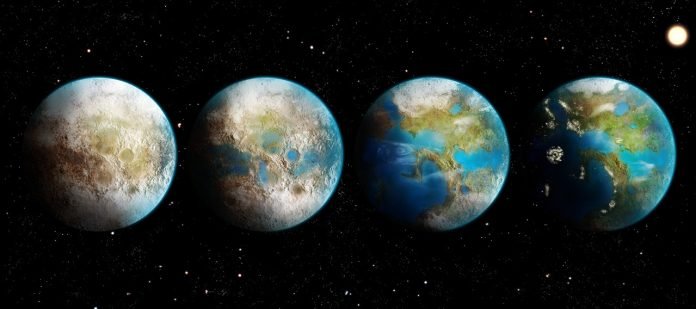
If aliens have modified a planet to make it warmer and more livable, we might be able to detect it.
A new study by researchers at the University of California, Riverside (UC Riverside) identifies artificial greenhouse gases that could be signals of such activity.
These gases could be detected in the atmospheres of planets outside our solar system using current technology like the James Webb Space Telescope or future telescopes.
A terraformed planet is one that has been artificially made suitable for life. The study’s authors suggest that certain gases, if found in a planet’s atmosphere, could indicate intelligent life forms altering their environment.
These gases would be detectable even in low concentrations with today’s technology.
On Earth, these gases are pollutants that need to be controlled to avoid harmful climate effects. However, on another planet, they might be used intentionally to make the environment more hospitable.
Edward Schwieterman, a UCR astrobiologist and the lead author of the study, explains, “For us, these gases are bad because we don’t want to increase warming.
But they would be good for a civilization that perhaps wanted to prevent an ice age or terraform an uninhabitable planet, like humans have proposed for Mars.”
Since these gases do not occur naturally in significant amounts, their presence would suggest they were manufactured, pointing to the existence of intelligent, technology-using life forms. These signals are known as technosignatures.
The researchers proposed five gases used on Earth for industrial applications, such as making computer chips.
These gases include fluorinated versions of methane, ethane, and propane, as well as gases made of nitrogen and fluorine or sulfur and fluorine. Their study, detailed in the Astrophysical Journal, highlights the benefits of these gases as potential indicators of alien activity.
One major advantage is that these gases are incredibly effective greenhouse gases. For example, sulfur hexafluoride has 23,500 times the warming power of carbon dioxide. Even a small amount could heat a freezing planet enough to sustain liquid water.
Another benefit, from an alien perspective, is that these gases are exceptionally long-lived, remaining in an Earth-like atmosphere for up to 50,000 years. “They wouldn’t need to be replenished too often for a hospitable climate to be maintained,” Schwieterman said.
Previous proposals suggested refrigerant chemicals like CFCs as technosignatures. However, CFCs can destroy the ozone layer and are short-lived, making them less ideal for this purpose. The fluorinated gases proposed in this study are chemically inert and longer-lasting.
These gases also absorb infrared radiation, creating a detectable infrared signature. Current or planned space-based telescopes could potentially identify these signatures in nearby exoplanetary systems. Schwieterman noted, “With an atmosphere like Earth’s, only one out of every million molecules could be one of these gases, and it would be potentially detectable.”
To test this idea, the researchers simulated a planet in the TRAPPIST-1 system, about 40 light-years away. This system has seven known rocky planets and is a prime target for space-based telescopes.
The study also considered the European LIFE mission, which could directly image planets using infrared light, targeting more exoplanets than the Webb telescope.
The research was conducted in collaboration with Daniel Angerhausen at the Swiss Federal Institute of Technology/PlanetS, and with researchers at NASA’s Goddard Space Flight Center, the Blue Marble Space Institute of Science, and Paris University.
While the likelihood of finding these gases soon is uncertain, the researchers are confident that detecting them is possible with current missions. “You wouldn’t need extra effort to look for these technosignatures if your telescope is already characterizing the planet for other reasons,” Schwieterman said. “It would be jaw-droppingly amazing to find them.”
Other team members share the excitement about the potential of finding signs of intelligent life and how current technology has brought us closer to that goal. Angerhausen added, “Our thought experiment shows how powerful our next-generation telescopes will be.
We are the first generation in history with the technology to systematically look for life and intelligence in our galactic neighborhood.”



